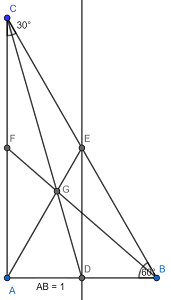Since I was in the process of making this solution, I will post it. It is slightly different to Cphill's solution, but the concepts used are mostly the same.
Generating a diagram for problems for geometry is generally a useful strategy so that one can visualize the problem and make observations. Here is the diagram that I will reference throughout the solving process:

I have included all the given information and labeled extra points and lines because I plan to use them while solving.
\(\triangle ABC\) has a 30- and a 60-degree angle. The remaining angle of the triangle, \(m\angle CAB=90^{\circ}\) . The triangle is therefore classified as a 30-60-90 triangle.
30-60-90 triangles have a special property: their side lengths are always at a constant ratio of \(1:\sqrt{3}:2\) . Since I know the length of \(\overline{AB}\) , 1, I can determine the lengths of the others by setting up a proportion.
| \(\frac{AB}{BC}=\frac{1}{2}\) | This is the proportion that I mentioned earlier. |
| \(BC=2AB\) | I am solving for BC to make the proportion into a simple equation. Substitute 1 for AB. |
| \(BC=2\) | |
Now we know that BC=2. In order to go further with this solution, you must know what a centroid is. A centroid is a point of concurrency where all three medians of a triangle intersect in the interior of the triangle. This means you must know what a median is. A median of a triangle is a line segment joining a vertex to the midpoint of the opposite side of that vertex. This information will help us.
In the diagram above, \(\overline{AE}\) is a median. Therefore, point E is a midpoint of \(\overline{BC}\) , so point E bisects the segment. Therefore, \(BE=\frac{BC}{2}=\frac{2}{2}=1\) . This means that we have identified two side lengths and the measure of one angle of \(\triangle ABE\) . You may already recognize it based on the sides and the angles that the triangle is equilateral, but you can use the law of cosines to find \(AE\).
| \(c^2=a^2+b^2-2ab\cos C\) | c is the length that we are trying to find. a and b are the side lengths that we know already. |
| \(AE^2=AB^2+BE^2-2*AB*BE*\cos60^{\circ}\) | Substitute all the known values and solve for the remaining side length. |
| \(AE^2=1^2+1^2-2*1*1*0.5\) | Simplify the right-hand side. |
| \(AE^2=2-1=1\) | Take the square root of both sides. |
| \(AE=1\) | Of course, in the context of geometry, the negative answer is nonsensical, so we reject the answer. This is the length of the median. |
The centroid is located at point G, and there is one property about centroids that we must know in order to crack this one. It is that it divides the median into a ratio of 2:1. \(\overline{AG}\) is contained within \(\overline{AE}\), so we can generate a system of equations.
| \(\boxed{1}\frac{AG}{GE}=\frac{2}{1}\\ \boxed{2}AG+GE=AE=1\) | This is a system of equations that we can solve for AG. |
| \(AG=2GE\\ GE=\frac{AG}{2}\) | I manipulated the first equation and wrote in terms of GE. I will substitute this into the second equation to solve for AG. |
| \(AG+\frac{AG}{2}=1\) | Multiply by 2 on both sides to eliminate the fraction. |
| \(2AG+AG=2\) | Combine the like terms on the left-hand side of the equation. |
| \(3AG=2\) | Divide by 3 on both sides of the equation. |
| \(AG=\frac{2}{3}\) | |
... And finally, we are done!